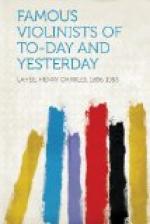Giovanni Battista Somis was born in Piedmont, and, after studying under Corelli, he went to Venice and studied under Vivaldi. He was appointed solo violinist to the king at Turin and leader of the royal band, and seems scarcely ever to have left Turin after these appointments. Little is known of his playing or his compositions, but, by the work of his pupils, it is evident that he possessed originality. He formed a style more brilliant and more emotional, and caused a decided step forward in the art of violin playing. He was the teacher of Leclair, Giardini, and Chiabran, as well as Pugnani, and he forms a connecting link between the classical schools of Italy and France.
Pietro Locatelli was born at Bergamo, and became a pupil of Corelli at a very early age. He travelled considerably, and was undoubtedly a great and original virtuoso. He has been accused of charlatanism, inasmuch as he overstepped all reasonable limits in his endeavours to enlarge the powers of execution of the violin, and has, on that account, been called the grandfather of our modern “finger-heroes.”
Locatelli settled in Amsterdam, where he died in 1764. There he established regular public concerts, and he left a number of compositions, some of which are used at the present day.
Jean Baptiste Lulli, one of the earliest violinists in France, is perhaps associated with the violin in a manner disproportionate to the part he actually played in its progress. He was a musician of great ability, and his compositions are occasionally heard even to this day. Lulli was born near Florence about 1633. When quite young he was taken to France by the Chevalier de Guise, and entered the service of Mlle. de Montpensier. He was employed in the kitchen, where he seems to have lightened his burdens by playing tricks on the cook and tunes on the stewpans. He also beguiled his leisure hours by playing the violin, in which art he made such progress that the princess engaged a regular instructor for him. Fortunately, as it turned out, his wit led him into composing a satirical song on his employer, and he was sent off, but shortly afterwards secured a post as one of the king’s violinists in the celebrated band of the twenty-four violins. Soon after this a special band called Les Petits Violons was formed with Lulli at their head, and under his direction it surpassed the band of twenty-four.
Lulli found great favour at court, and, indeed, astonished the world with his exquisite taste and skill. That he was firmly established in the favour of the king is shown by the story that, when Corelli came to France and played one of his sonatas, King Louis listened without showing any sign of pleasure, and, sending for one of his own violinists, requested him to play an aria from Lulli’s opera of “Cadmus et Hermione,” which, he declared, suited his taste.
There is little doubt that the principles of the great Italian school of violin playing were, some years later, brought into France by Anet, who was born in 1680, and returned from Italy about 1700, but owing to the jealousies of his colleagues, he found it advisable to leave France in a short time, and he is said to have spent the rest of his life as conductor of the private band of a nobleman in Poland.




